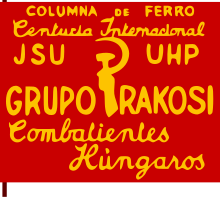Rákosi Battalion
The Rákosi Battalion (Rakosi) was a largely Hungarian battalion of the International Brigades in the Spanish Civil War . Between 524 and 1500 Hungarians , mostly well-educated communists, served in the Rakosi battalion . The battalion was named after the socialist Rákosi group, which joined the militia units. The group was named after Mátyás Rákosi , a Marxist politician from Hungary. When the name was given, Mátyás Rákosi was in prison in Hungary under the Horthy regime .
Like all battalions, the battalion was organized and looked after by the Comintern and the Soviet security service NKVD . Political commissioner of the Rákosi battalion was László Rajk , who later became the Hungarian interior minister and foreign minister. Furthermore Ferenc Münnich (pseudonym Otto Flatter), who later also became political commissioner of the XI. International Brigade (Thälmann) was. From 1958 to 1961 he was Prime Minister of Hungary.
history
JSU / UHP militiamen
On July 19, 1936, the Hungarian participants who were in Barcelona for the opening of the People's Olympiad joined the republican militia . They formed the Rákosi group . This joined a socialist militia unit of the Juventudes Socialistas Unificadas (JSU) and Uníos Hermanos Proletarios (UHP) and fought on the Aragon Front . The Rákosi unit was later in the XI. International Brigade and was the nucleus of the Rákosi battalion.
XI. International Brigade (Thälmann)
The international Columnas (columns) and Centurien ( Hundreds ) were reorganized after the decision of September 28, 1936 to set up the International Brigades (Mixta Brigade) . As the JSU / UHP militia unit Columna de Ferro , the Hungarian militiamen became a unit in the XI. International Brigade. The XI. International Brigade consisted of three battalions. The Edgar André battalion , with the tough veteran core of the Thälmann column , the Hungarian Columna Rákosi (Rakosi) and a British machine gunner Columna; the Franco-Belgian Commune de Paris battalion and the Polish Dąbrowski battalion .
International Brigades
On June 23, 1937, the Rákosi Battalion became part of the 150th Brigade along with the Dąbrowski Battalion , the André Marty Battalion, and the Palafox Battalion . It was a mixed brigade, Brigada Mixta . In July 1937 the Pole Józef Strzelczyk (pseud. Jan Barwiński) took command of the 150th Brigade. The brigade was moved to the front in front of Brunete with other units of the International Brigades . The 150th Brigade at that time consisted of around 1910 soldiers. At the Battle of Brunete on July 6, 1937, the 150th Brigade suffered heavy losses. Then the 150th Brigade fought in August 1937 on the Aragon Front , near Teruel , in defensive battles in Almería and on the fronts of Granada and Córdoba . After this fighting of the 150th Brigade, the Rákosi Battalion of the XIII. Assigned to the International Brigade .
13th Brigada Mixta
On October 1, after the Battle of the Ebro, the 13th Brigada Mixta was set up with the remaining brigadists . This brigade consisted mainly of Spaniards. Its commanding officer was Enrique Escudero Serrano . After a short time, the battalion set up again intervened in fighting on the Ebro, covering the retreat of the 35th Division in the Barranc Fosc gorge . It was the last unit to retreat across the Ebro near Filx on November 16, 1938 .
Catalonia offensive
The government of the Spanish Republic agreed to the dissolution of the International Brigades on September 24, 1938 , partly because of pressure from the League of Nations . In January 1939, therefore, the stateless Hungarian brigadists of the Rákosi battalion again submitted to the command of the Spanish People's Army. The brigadists were reactivated on January 23, 1939 in La Garriga , during Franco's Catalonia offensive, with the former brigadists of the Dąbrowski battalion , Palafox battalion and Mickiewicz battalion . The Hungarian Miklos Szalway (pseudonym Tschapajew) became the commander of the Rákosi battalion . The battalion fought with the Dąbrowski battalion under the designation XIII. International Brigade Dąbrowski . From January 26 to January 29, 1939 near La Garriga and from February 2, 1939, the brigadists with other units of the Spanish People's Army in Cassà de la Selva near Girona stopped the advance of the nationalist troops for two days. During an absolutely chaotic retreat via Girona, the brigadists reached the French border at El Pertus . They crossed the border with the Spanish People's Army on February 7, 1939, where the stateless Polish brigadists were interned in the internment camp Argelès-sur-Mer .
Individual evidence
- ↑ Sebastián Herreros Agüí: The International Brigade in the Spanish War 1936 (English)
- ↑ The International Brigadas in the Spanish War 1936-1939: Flags of Symbols: Section 1.5. The Rákosi Group (English; PDF; 6.4 MB), accessed on August 27, 2012
- ^ La batalla de Guadalajara: BRIGADA INTERNACIONAL 1937 »Ballad of the XI. Brigade «(Ernst Busch) (Spanish) , accessed on May 13, 2012
- ↑ Sebastián Herreros Agüí: The International Brigade in the Spanish War 1936 (English)

